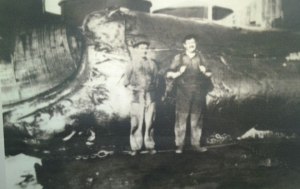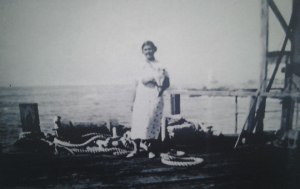
Early History of the farm Waaygat
The land on which the whaling station was established originally formed part of the farm Waaygat. Historically and geographically the whaling station formed and integral part of the history of Betty’s Bay area. Waaygat passed through the hands of several owners from 1824, including Sir Robert Stanford after which a nearby town is named. ln March 1899 the brothers John and William Walsh paid £2000 for some land which included Waaygat. William Walsh died in 1912 leaving his brother John as sole owner of all the property.It was at this time that the Hangklip Whaling Station was established and run on the farm. A certain Frank Cook signed a three year lease with the Hangklip Estate, the land that belonged to the Walsh family.
Whaling was undertaken by3 different companies from the Hangklip.

1. The Southern Cross Whaling Company, Limited
The building and machinery were erected during 1912 under supervision of a Mr Bernstein and his son, natives of the town Larvick in Norway, who had experience in the whaling industry.
The building of the factory was completed in probably less than a year at the cost in excess of £31 000 and was ready for the 1913 whaling season that lasted from May- October. Two newly acquired steam whalers, Blink and Southern Cross caught 112 and 67 whales respectively that year.
A single record regarding the number and value of the whale catch in 1914 indicated that 84 whales to value of £12,936 were taken in that year. This report was submitted by the unknown manager of the company who subsequently died. The whaling activities seemed to have affected the whaling activities as by 1915 the Southern Cross Whaling Co. was in liquidation.

The 1914 catch was already down on that of 1913. Although unconfirmed, the outbreak of the First World War would have had an influence on the production.
No whaling took place during 1915. The buildings were taken care of by a caretaker who also maintained the machinery whilst the steam whaling vessels had been leased and were in use in Durban.
2. The Shepstone Whaling & Fishing Company
The assets of Southern Cross Whaling were bought by the Shepstone Whaling & Fishing Co. The plan was fully operational by March 1916 and they landed their first whale catches in 1916 in Durban. The company owned a fleet of three steam powered whaling boats and employed 144 people which had increased to 220 by the end of 1917. By now the fleet had increased to 6 steam vessels, some of which might have been whale catchers and some were cargo vessels for transporting whale products to Cape Town. The whale catches of the three whaling vessels Frey, Eao and the Mossel was managed by Mr G.D.Irvin, managing director of Messrs Irvin & Johnson, the Cape Town agent for the company.

No whaling was undertaken at Waaygat during the 1919 season but activities resumed again in 1920. While 107 whales were landed at Hangklip in the earlier months of 1920, the September catch was delivered to Donkergat whaling station in Saldahna Bay which was by being run by Irvin & Johnson Ltd. The reason might have been that Irvin & Johnson Ltd had by 1917 acquired most of the minority shares in the Shepstone Company and were thus looking after their own interests.

There was again no whaling during 1921 and in 1922 the whaling station did not re-open. From then until 1926 Mr John West was appointed as the deserted whaling station manager.His daughter, later a Mrs Johannessen had fond memories of the almost 10 years they stayed at the station.
While the precise reasons for the erratic operation of the Hangklip whaling station during these years are unknown, it is likely that economic factors were to blame. It is reported that a large whale oil stockpiles were available on the international market and that production cost had become very high.

3. Irvin & Johnson
When discussing I & J’s involvement in whaling, we have to step back a number of years to 1903 when the first privately owned trawler, Berea, belonging to Mr Charles Johnson, began operating from Table Bay. At the same time in England, another trawling firm, Richard Irvin & Sons, had also decided to begin fishing in southern African waters and had registered a company known as the African Fishing and Trading Company Limited for this purpose. They sent two trawlers to Cape Town, which arrived shortly after Brea in 1093 and Mr George Irvin was sent to Cape Town to manage the business.
The first contract between the two fishing companies came about when Johnson approached Irvin with a request to help his dispose of the Berea’s catches, Shortly after this Johnson moved his fishing operation to Durban and eventually both him and the African Fishing and Trading Company Ltd began railing catches to Johannesburg where a large market for their products was discovered.

Both companies prospered as a result and in 1909 the African Fishing and Trading Company Ltd represented by Irvin and Charles Johnson, entered into a partnership under the title Irvin & Johnson. The partnership was so successful that in 1912 it was decided to form a limited liability company under the name Irvin & Johnson.
Despite the success if the fish trawling business, Charles Johnson was always more interested in whaling and as early as 1909 a company called Southern Whaling and Sealing Company was registered by him. The shareholders were African Fishing and Trading Co Ltd and Mr C O Johnson.

Initially whaling took place in Antartica and a ship was required and converted into a floating factory to process catches. Shore stations were soon established at Prince Olof Harbour, South Georgia and another at Port Alexandra. By 1912, Southern Whaling had bought the controlling interest in the Shepstone Whaling and Fishing Company who was at that time operating from Durban. Southern also held lease of a shore whaling station at Donkergat in Saldanha Bay.

In 1917 I&J decided to start their own whaling activities. As a result they bought out the entire Southern Whaling and Sealing Company including the lease of the Donkergat whaling station. They also acquired most of the minority shares in the Shepstone Whaling and Fishing Company. At some point between 1921 and 1926 they took full control of Shepstone and thereby acquiring full control of Hangklip station. After 5 yearsof inactivity, whaling from Hangklip commenced again under Irvin & Johnson.

In an attempt to improve conditions in the “’harbour”’ the old steamer, Una from the I&J fleet was sunk to form a jetty alongside the slipway. The station was operated until 1930 after which no more whaling took place from the site. It is likely that economic factors and most likely the cost of running two shore stations, Donkergat and Hangklip, may have become too costly.
By 1935, following the death of Lillian Walsh, the widow of John Walsh, Waaygat was sold to the Hangklip Syndicate.
Waaygat whaling station was operated until 1930 after which no more whaling took place from the site. While the layout seemed to have remained much the same over the years, some modifications were obviously made.
The Blubber House
The Blubber House contained several boilers. Piece of blubber were put into the boilers where steam was injected to melt the fat. After about10 hours the oil floated to the surface, was skimmed off and sent to settling tanks. The residue, termed ‘glue-water’ was [piped to the meat house for further processing.

The Cutting Plane
Whale carcasses were dragged up the wooden slipway onto the cutting plane, Special curved flensing knifes were used to cut off the skin from the attached layer of fat ( blubber). The cutting plane was covered in wood so that the flensers could use their nailed boots to get a grip on the fat-slippery surfaces.

The Meat House
It was a double storey shed with 2 rows of large upright cylindrical cookers. The whale meat and bones are oily and was sometimes boiled for up to 16 hours. By prolonged pressure cooking these oils were melted out and drained off. De-oiled ‘glue-water was run off and the meat and bones were sent to the meal and guano factory.
The Guano Building

The stewed meat was de-boned and hot air was used to to dry the meat.This was milled and sold as meal for livestock. ‘Glue-water’ contained fine solids.The liquid was dried off and solid remnants were ground to become meal. The remaining bones were pulverised to peppercorn size. Whale bone fertiliser was marketed as guano.
The Story of the UNA
From the cold water and fogs of the North Sea to the sunny, warm water of the West Australian Coast and finally halfway across the world again to South Africa, all in a space of 36 years, was the lot of a small, unpretentious ship, well known in Table Bay just over forty years ago. She was the steam trawler UNA of the Irvin & Johnson fleet.
The UNA was built in 1890 by Cochrane & Co of Beverley, Yorkshire. For the first 14 years of her life she was engaged in deed sea fishing. However, in 1904, she was purchased by J W Bateman, owner of a number of boats working from Freemantle and she made the long voyage to Australia. It was the new owners’ intention to use UNA for general work including fishing and sponge work but she ended up carrying cargo. Among her duties at times were salvage work.
When Bateman’s began disposing of their vessels and developing their land interests the UNA was the last to be sold. The UNS remained with the new owners till 1912 when she was purchased to become the first vessels in a new venture, to carry mail and cargo on the South Coast run. Built originally for fishing she had no passenger accommodation, but to remedy this a temporary deck house was built on the hatch cover, When the cargo had to worked out of the hold it was first necessary to lift the hatch cover, complete with deck house, on to the wharf.
In later years Captain Douglas would remark that he had been given command of a submarine as UNA spent much of her time ploughing under the water and she became affectionately known as ‘”the submarine”.
In 1917 she sailed for South African waters, having being bought by Irvin & Johnson from their trawling fleet. Although UNA was the oldest she was the second largest vessel in the fleet and became a familiar feature in Cape Town,is charging her cargoes of fish from the Agulhas Banks and, nearing the end of her life, she was again performing the task for which she was built.

With the advent of newer vessels after the end of the War, she became redundant. In addition to their trawling fleet Irvin & Johnson operate whalers and sealers. South of Hangklip the company operated a whaling station that was maintained at Stony Point,near Betty’s Bay. In May 1926 UNA’s useful seagoing life was declared over and she was towed to Stony Point and scuttled to for a jetty.
Nowadays there is little of UNA left, except part of her stern rusting away badly, with small fish darting in and out through the old plates. A very humble little vessel, the UNA, with quite a career.
Source: Flotsam & Jetsam














